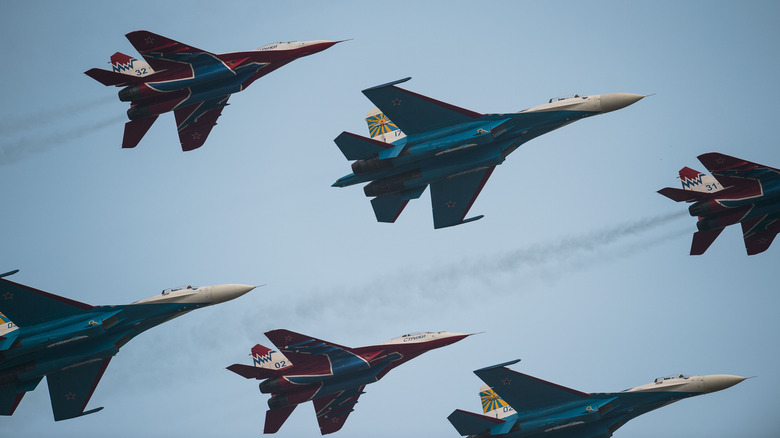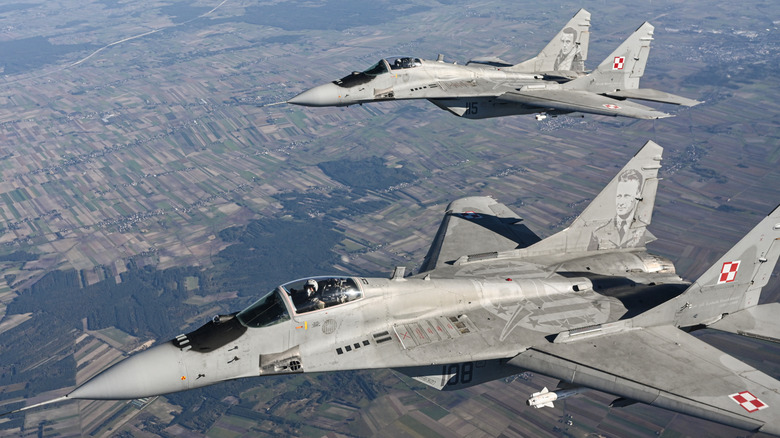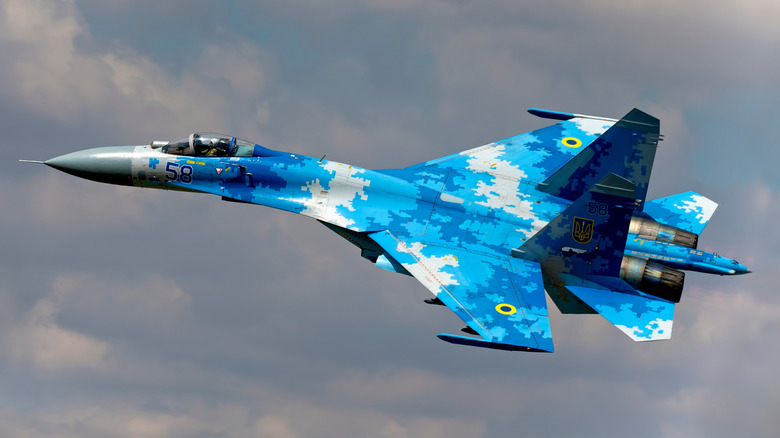MiG-29 Vs Su-27: How The Soviet Fighter Jets Compare
The Cold War was a significant era that came off the heels of World War II and almost immediately turned allies into acquaintances kept at arms-length, gradually devolving into rivals. Every country was under a heightened level of anxiety, afraid of saying or doing the wrong thing. However, to keep each other in check, the major powers expanded their military strength, building new vehicles and weapons, and improving on outdated technology. The Soviet Union did what it could to keep up with America's might, designing fighter jets to counter some of the best fighters in the skies.
The MiG-29 and Su-27 were two of the USSR's top jets and they've stood the test of time, continuing to fly in modern combat zones. They were both designed in the '70s but weren't delivered to their operators until the '80s. The MiG-29 was the first of the two out the gate in 1983, while the Soviet Air Force didn't receive the Su-27 until 1985.
Both planes had their own distinct purpose. The MiG filled multiple roles, from air-to-air combat to air-to-ground attack missions. Engineers for the Su-27 set out to make it a plane that could defend well against other airborne targets from fighter jets to bombers. Here's how the two compare.
MiG-29
The Mikoyan MiG-29 fighter – NATO reporting name Fulcrum – took flight during the Cold War as a counter to the United States Air Force's agile F-16, but initially it wasn't much competition. Early designs weren't something one would expect from a newer fighter jet as its engineers weren't experienced with up-to-date practices. Unlike the jet it was supposed to go toe-to-toe with, its airframe was crafted from aluminum rather than a mixture of composite materials and its flight control system used conventional hydraulics as opposed to the more advanced fly-by-wire controls. Engineers eventually discovered these deficiencies and made some adjustments, turning the Fulcrum into a viable threat.
Thanks to advanced sensors like the Slot Back Doppler radar, infrared tracking sensors, and a laser rangefinder, Fulcrum pilots could engage with targets that flew below them. The Soviet jet used a helmet-mounted targeting system that removed the need for pilots to turn the Fulcrum toward their target. As long as they kept their head aimed at enemy aircraft, the missile about to be launched would lock onto its target. According to thinktank the Royal United Services Institute this, along with the jet's thrust-to-weight ratio and agility, made it "almost unbeatable" in one-on-one engagements within visual range. That combination also made the MiG-29 a desirable fighter jet for other countries.
This multi-role fighter was armed with a 30mm GSh-301 cannon, could carry six air-to-air missiles as well as bombs and rockets, and could go as fast as Mach 2.3.
Sukhoi SU-27UB
The twin-engine Su-27 – NATO gave it the name Flanker – might have been the second of these two Soviet fighters to be delivered, but it was easily the peak of Soviet aeronautical design. Production of the Flanker had one goal and one goal only: To outperform the USAF's F-15 Eagle. The design phase for the Su-27 started off rocky as the lead designer, Mikhail Simonov, was unhappy enough with everything to halt its production and start designing the jet again from scratch. According to The Smithsonian, Simonov is popular for saying, "We kept just the tires and the pilot's seat." Production resulted in the Su-27P, the interceptor version designed to dominate the skies, and the Su-27S, which could be armed with air-to-ground weapons.
It's not the most advanced fighter in sky today, since fifth generation fighter jets can fly circles around it, but both Russia and Ukraine use it in their air forces. Ukraine has since modified its inventory of Flankers, designating them Su-27M1, fitting them with improved navigation systems and a radar system with increased range.
Overall, it sports one 30mm Gryazev-Shipunov GSh 301 cannon and a combination of radar-guided and infrared-homing air-to-air missiles to maintain its air superiority. For other roles, it can be armed with conventional or cluster bombs as well as air-to-ground rockets. Its two Saturn AL-31F engines can each produce 27,640 pounds of thrust each and get the jet up to Mach 2.35 and reach a maximum 2,193 miles before it needs to refuel.


